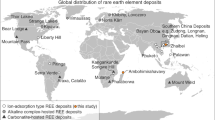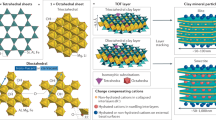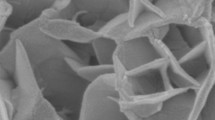Abstract
A legacy of the nuclear industry that threatens many areas of the world is contamination by radioactive radium from the solid and liquid wastes left after extracting uranium from its ores. Here we describe a highly charged, synthetic clay that specifically removes radium and immobilizes it at room temperature for safe disposal. This material may prove to be useful in decontaminating drinking water wells and soils of this toxic isotope.
Similar content being viewed by others
Main
Synthetic cation exchangers have been tailored for decontaminating the environment of radioactive isotopes such as 137Cs and 90Sr (refs 1–3) and immobilizing them through electrostatic bonding2,3 at room temperature. There is also a need for selective exchangers for the uptake of radium because not only is this isotope extracted into groundwater from uranium wastes but naturally occurring uranium may also contaminate drinking-water wells. Radium must be filtered out of drinking water to protect the populace from cancer and other health risks4,5.
Two synthetic micas of nominal composition Na4Al4Si4Mg6O20F4·xH2O ('Na-4-mica') and another two of nominal composition Na2Al2Si6Mg6O20F4·xH2O ('Na-2-mica') were prepared from sol–gel precursors3 (gel method) or by using metakaolinite and MgO as precursors6 (kaolinite method) in sodium fluoride at 890 °C. We compared the uptake properties of several natural montmorillonite clays and of these synthetic clays.
Selective uptake of radium was determined using 0.5 M, 1.0 M or 2.0 M NaCl containing 226RaCl2 at about 6 × 10−9 M. These solutions have extremely large equivalent ratios of [Na+]/[Ra2+] (0.6 × 108, 1.2 × 108 and 2.4 × 108 in 0.5, 1.0 and 2.0 M NaCl solutions, respectively). Aliquots of the solution (20 ml) and sorbent powder (20 mg) in a centrifuge tube were equilibrated at room temperature. After 24 h, the solid and solution phases were separated and the 226Ra concentration in solution was determined. The selective uptake of radium is expressed as the distribution coefficient Kd.
Table 1 shows that Na-4-mica is the best of all the clays tested at taking up radium from solutions containing 60 to 240 million times more sodium than radium. This mica removed 95.4 ± 0.3% radium from 0.5 M NaCl solution. Its high charge density and special structure of offset layer stacking means that Na-4-mica prefers to take up fewer hydrated monovalent and divalent ions3, which accounts for its superselectivity towards radium.
To investigate this selective uptake by Na-4-mica, we determined the equilibrium Na/Ba exchange isotherm using barium as a substitute for radium7. The shape of this isotherm2,3 also reveals the nature of the uptake process8. Results shown in Fig. 1 indicate that the mica prefers Ba2+ in the region of low concentration (initially steep curve), but then exchange stops (flat curve caused by the collapse of the interlayer space)3,8. This type of interlayer collapse occurs in layered clays because of electrostatic bonding2,3 with ions of low hydration such as Cs+, Rb+ and Sr2+.
Calculations from the equilibrium isotherm (Fig. 1) show that about 25% of the available barium enters the Na-4-mica interlayers, corresponding to a capacity of 115 mequivalents per 100 g, before collapse of the interlayers prevents further exchange. Radium ion, which is less hydrated than barium ion, should not be taken up to the same extent as barium as it is more likely to be trapped (immobilized) in the interlayers after fractional exchange owing to electrostatic and steric factors.
This special superselective mica could be used to help solve not only the radium-separation problem, but also its fixation and safe disposal.
References
Komarneni, S. & Roy, R. Nature 299, 707–708 (1982).
Komarneni, S. & Roy, R. Science 239, 1286–1288 (1988).
Paulus, W. J. et al. Nature 357, 571–573 (1992).
Finkelstein, M. M. Can. Med. Assoc. J. 151, 565–571 (1994).
Lyman, G. H., Lyman, C. G. & Johnson, W. J. Am. Med. Assoc. 254, 621–626 (1985).
Komarneni, S., Pidugu, R. & Amonette, J. E. J. Mater. Chem. 8, 205–208 (1998).
Jurado Vargas, M., Olguin, M. T., Ordonez Regil, E. & Jimenez Reyes, M. J. Radioanalyt. Nuclear Chem. 218, 153–156 (1997).
Breck, D. W. Zeolite Molecular Sieves (Krieger, Malabar, 1984).
Author information
Authors and Affiliations
Corresponding author
Rights and permissions
About this article
Cite this article
Komarneni, S., Kozai, N. & Paulus, W. Superselective clay for radium uptake. Nature 410, 771 (2001). https://doi.org/10.1038/35071173
Issue Date:
DOI: https://doi.org/10.1038/35071173
This article is cited by
-
Decorating Covalent Organic Frameworks with High-density Chelate Groups for Uranium Extraction
Chemical Research in Chinese Universities (2022)
-
Potassium Niobate Nanolamina: A Promising Adsorbent for Entrapment of Radioactive Cations from Water
Scientific Reports (2014)
-
Salinity dependence of 226Ra adsorption on montmorillonite and kaolinite
Journal of Radioanalytical and Nuclear Chemistry (2014)
-
Killing of Gram-Negative Bacteria with Normal Human Serum and Normal Bovine Serum: Use of Lysozyme and Complement Proteins in the Death of Salmonella Strains O48
Microbial Ecology (2009)
-
NMR Studies of Heat-Induced Transitions in Structure and Cation Binding Environments of a Strontium-Saturated Swelling Mica
Applied Magnetic Resonance (2007)
Comments
By submitting a comment you agree to abide by our Terms and Community Guidelines. If you find something abusive or that does not comply with our terms or guidelines please flag it as inappropriate.




